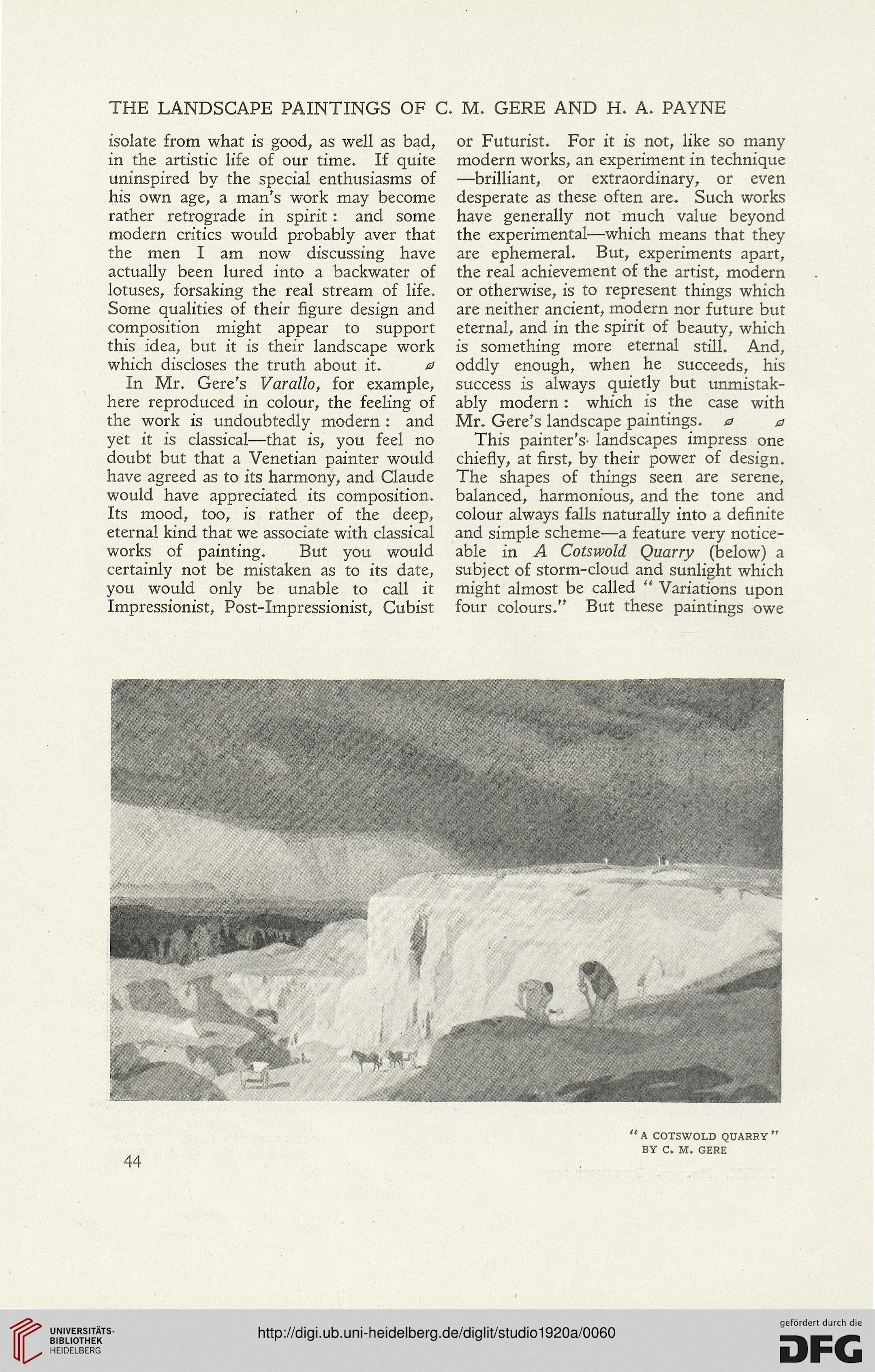THE LANDSCAPE PAINTINGS OF C. M. GERE AND H. A. PAYNE
isolate from what is good, as well as bad,
in the artistic life of our time. If quite
uninspired by the special enthusiasms of
his own age, a man's work may become
rather retrograde in spirit: and some
modern critics would probably aver that
the men I am now discussing have
actually been lured into a backwater of
lotuses, forsaking the real stream of life.
Some qualities of their figure design and
composition might appear to support
this idea, but it is their landscape work
which discloses the truth about it. a
In Mr. Gere's Varallo, for example,
here reproduced in colour, the feeling of
the work is undoubtedly modern : and
yet it is classical—that is, you feel no
doubt but that a Venetian painter would
have agreed as to its harmony, and Claude
would have appreciated its composition.
Its mood, too, is rather of the deep,
eternal kind that we associate with classical
works of painting. But you would
certainly not be mistaken as to its date,
you would only be unable to call it
Impressionist, Post-Impressionist, Cubist
or Futurist. For it is not, like so many
modern works, an experiment in technique
—brilliant, or extraordinary, or even
desperate as these often are. Such works
have generally not much value beyond
the experimental—which means that they
are ephemeral. But, experiments apart,
the real achievement of the artist, modern
or otherwise, is to represent things which
are neither ancient, modern nor future but
eternal, and in the spirit of beauty, which
is something more eternal still. And,
oddly enough, when he succeeds, his
success is always quietly but unmistak-
ably modern: which is the case with
Mr. Gere's landscape paintings, a 0
This painter's- landscapes impress one
chiefly, at first, by their power of design.
The shapes of things seen are serene,
balanced, harmonious, and the tone and
colour always falls naturally into a definite
and simple scheme—a feature very notice-
able in A Cotswold Quarry (below) a
subject of storm-cloud and sunlight which
might almost be called " Variations upon
four colours." But these paintings owe
44
" A COTSWOLD QUARRY "
BY C. M. GERE
isolate from what is good, as well as bad,
in the artistic life of our time. If quite
uninspired by the special enthusiasms of
his own age, a man's work may become
rather retrograde in spirit: and some
modern critics would probably aver that
the men I am now discussing have
actually been lured into a backwater of
lotuses, forsaking the real stream of life.
Some qualities of their figure design and
composition might appear to support
this idea, but it is their landscape work
which discloses the truth about it. a
In Mr. Gere's Varallo, for example,
here reproduced in colour, the feeling of
the work is undoubtedly modern : and
yet it is classical—that is, you feel no
doubt but that a Venetian painter would
have agreed as to its harmony, and Claude
would have appreciated its composition.
Its mood, too, is rather of the deep,
eternal kind that we associate with classical
works of painting. But you would
certainly not be mistaken as to its date,
you would only be unable to call it
Impressionist, Post-Impressionist, Cubist
or Futurist. For it is not, like so many
modern works, an experiment in technique
—brilliant, or extraordinary, or even
desperate as these often are. Such works
have generally not much value beyond
the experimental—which means that they
are ephemeral. But, experiments apart,
the real achievement of the artist, modern
or otherwise, is to represent things which
are neither ancient, modern nor future but
eternal, and in the spirit of beauty, which
is something more eternal still. And,
oddly enough, when he succeeds, his
success is always quietly but unmistak-
ably modern: which is the case with
Mr. Gere's landscape paintings, a 0
This painter's- landscapes impress one
chiefly, at first, by their power of design.
The shapes of things seen are serene,
balanced, harmonious, and the tone and
colour always falls naturally into a definite
and simple scheme—a feature very notice-
able in A Cotswold Quarry (below) a
subject of storm-cloud and sunlight which
might almost be called " Variations upon
four colours." But these paintings owe
44
" A COTSWOLD QUARRY "
BY C. M. GERE




